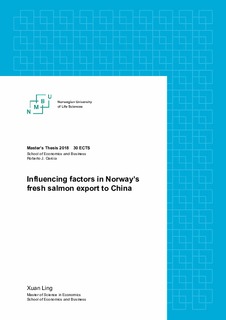| dc.description.abstract | With the governments long term vision of restructuring Norway to a
competitive, low carbon footprint society, a vision labeled “Green Compet-
itiveness”, how to replace oil becomes a key concern. The government has
singled out marine aquaculture as the example to emulate. The growth of
the industry depends on markets with growth potential and, with its size
and rapid growth, China is particularly attractive.
The objective of the study is the attainment of a broad view for success-
ful strategies to realize the vision of “Green Competitiveness”, particularly
in relation to the Norway-China fresh salmon trade. To the best of my
knowledge, previous, related research either address other issues or, with
depth, lack scope. The key research question is: what are factors that de-
termine the success of Norwegian salmon exports to China in the period
from January 2000 to August 2017.
The study includes variables for well known interactions related to
China’s import demand - income, price and substitute price, exchange
rate as well as sanctions against the trade. An autoregressive distributed
lag (ARDL) model is built, and ordinary least squares (OLS) estimation
method is applied to the model.
The findings indicate, within a 95% confidence interval, that Norwegian
fresh salmon, in the Chinese marketplace, is elastic with respect to income
by a cumulative factor of 1.09, and price inelastic by a factor of −0.27.
These are characteristics of a luxury product, with a degree of perceived
uniqueness, making it hard to replace. Substitute price increases have a
positive effect (0.88) on the import demand within a 90% confidence inter-
val. The study also found an overall limited effect of exchange rate, which
supports the findings of Xie et al. (2008). As expected, sanctions against
trade exerts strong negative influence on demand, with a demand curve shift
of 80.33 units.
The implication of these findings is that any strategy to maintain and
strengthen the position of Norwegian salmon in China, will do well to bol-
ster a luxury and uniqueness narrative for the national brand of Norwegian
salmon and “Seafood from Norway”. | nb_NO |

